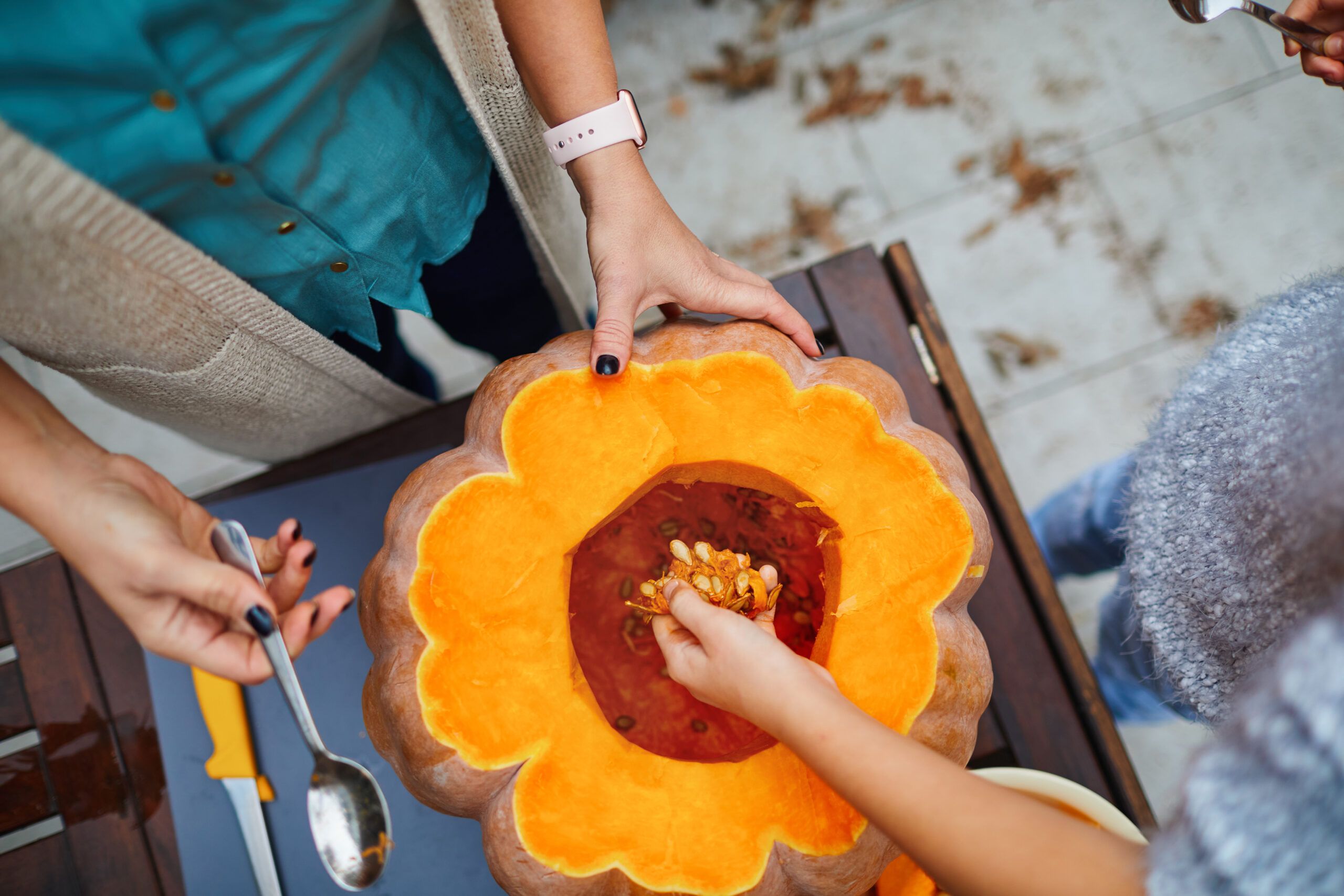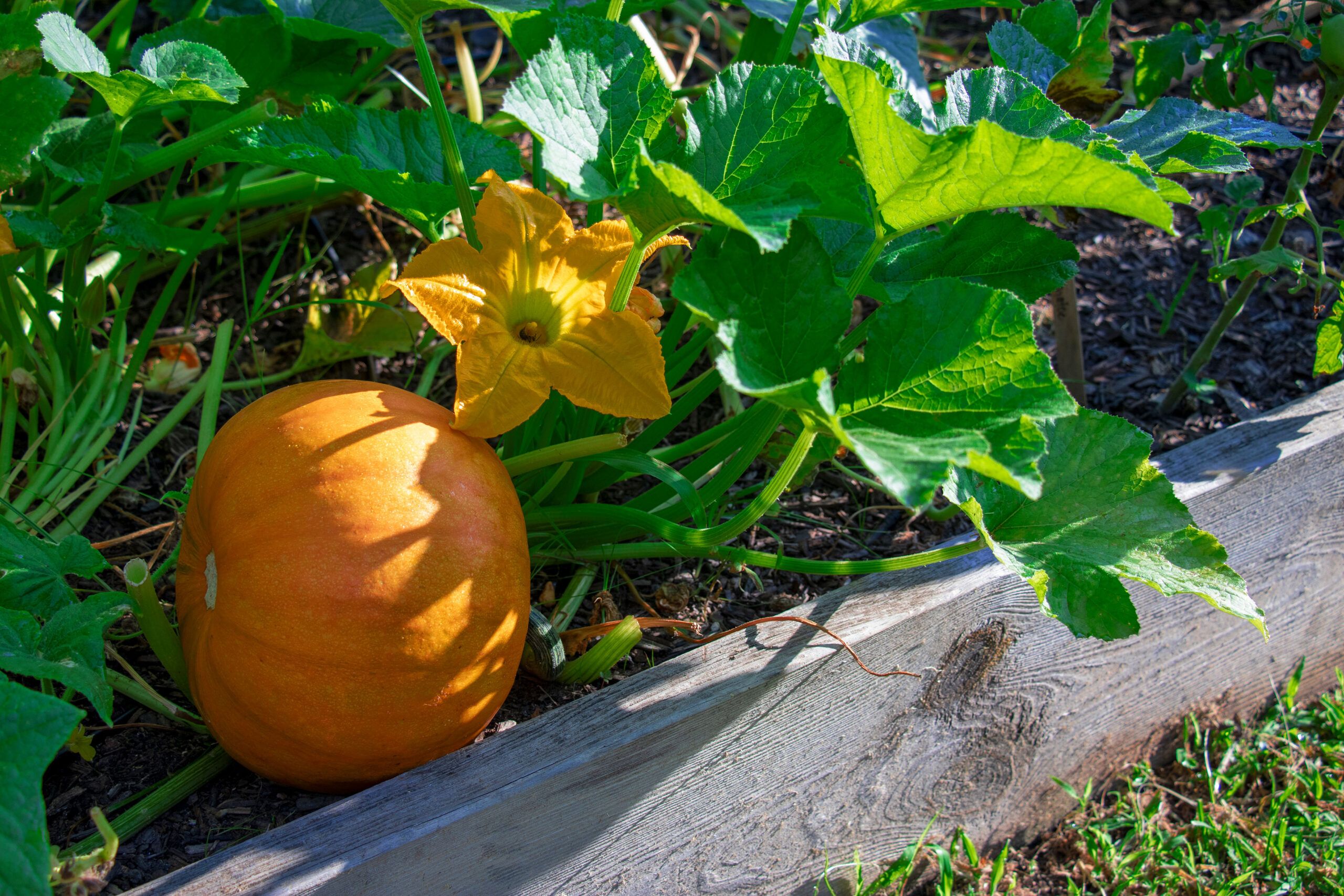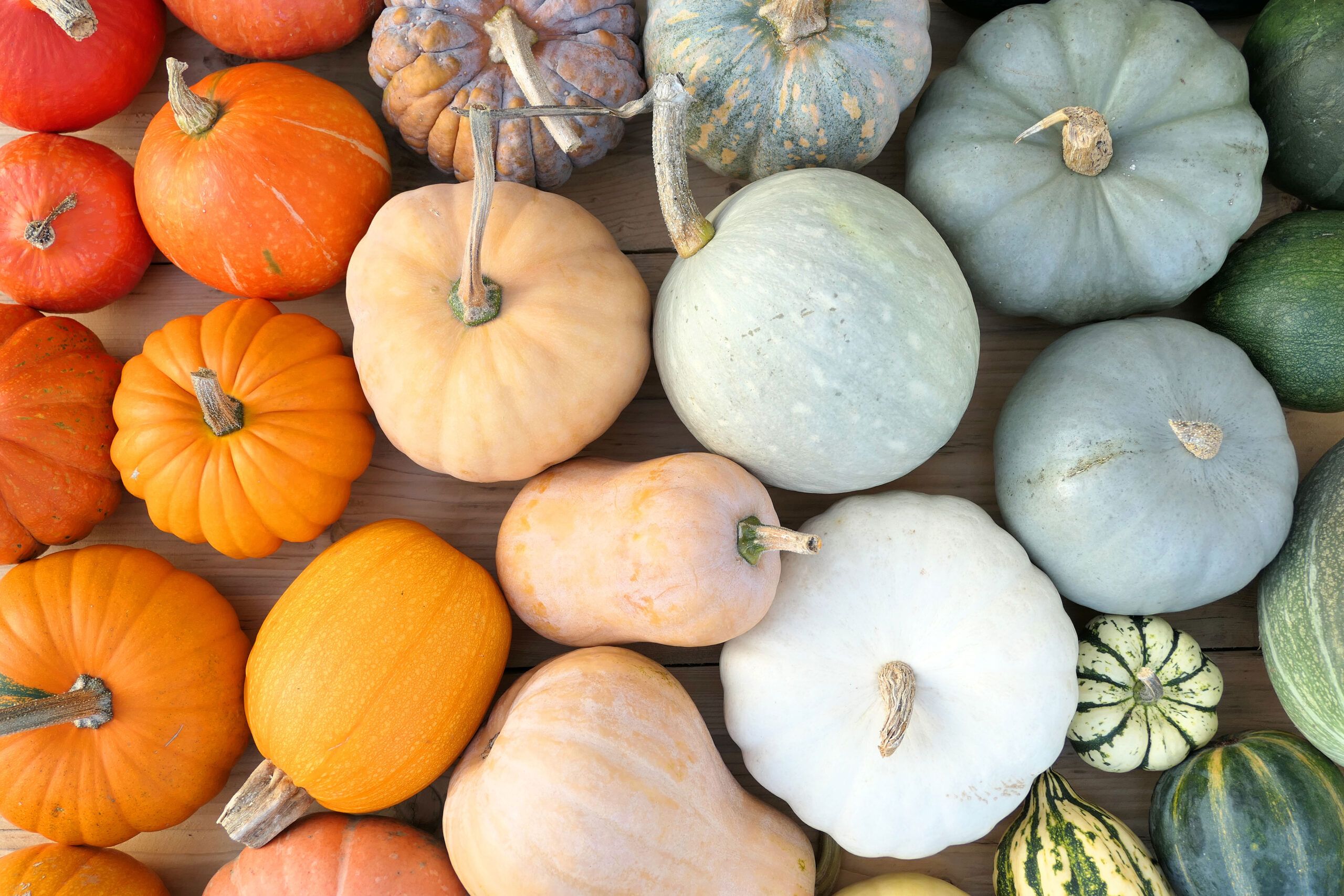Pumpkins are a quintessential symbol of autumn. They decorate homes and porches, fill pies, and flavor your favorite seasonal drinks. Whether you want to cut costs on canned pumpkin for baked goods or harvest your own jack-o’-lantern, growing your own pumpkins is simple.
With the right knowledge and a bit of outdoor space, you can cultivate a bountiful pumpkin harvest in your own backyard. This guide will walk you through the process of planting, growing, and caring for pumpkins, making sure you have a plentiful supply for all your autumn needs.
Part I: Stockpile Pumpkin Seeds in the Fall
Pumpkins are members of the Cucurbitaceae family, along with squash, cucumbers, and melons. They’re typically planted in late spring or early summer. But you can get a head start in autumn by saving seeds from fall pumpkins you’re using for cooking or decoration. This sets you up for success when the planting season arrives.
Decide Which Kind of Pumpkins You Want To Grow
The type of pumpkin you choose to grow depends on how you want to use them. For culinary purposes, small sugar pumpkins are ideal. These varieties often include words like “sugar,” “sweet,” or “pie” in their names and have dry, sweet flesh that’s less fibrous than larger pumpkins.
For decorative purposes or carving jack-o’-lanterns, medium to large pumpkins are better suited. There’s also a wide range of colors and shapes available, from classic orange to ghostly white, pale yellow, and even blue-green varieties.
Factor in your local climate and growing conditions. Some pumpkin varieties are more suitable for certain areas and soil types. Find out which plant hardiness zone you’re in, so you can choose a pumpkin variety that works well in your climate.
Purchase a Locally Grown Pumpkin
Choosing a locally grown pumpkin is a smart move if you’re planning to save seeds for your garden. These pumpkins are accustomed to your area’s climate and soil, which means their seeds are more likely to flourish when you plant them. This boosts your chances of growing a successful crop, supports local farmers, and keeps your community thriving. Plus, it’s an eco-friendly option—by buying local, you’re cutting down on the carbon emissions that come from transporting pumpkins over long distances.
Gather the Seeds

Start by carefully cutting open your pumpkin and scooping out the pulp and seeds using your hands or a large spoon. Place the seeds in a colander and rinse them thoroughly under cold running water, making sure to separate them from any remaining pulp. Once they’re clean, spread the seeds out on a paper towel to dry.
Since pumpkins often yield a large number of seeds, take your time selecting the best ones. Look for the largest and plumpest seeds, as these have the best chance of germinating. But don’t worry about being too picky—planting several seeds in each hole increases the likelihood that at least one will sprout.
Get your kids involved in this process, too. It’s a fantastic opportunity for them to learn about gardening and the plant lifecycle. Saving and planting seeds can help foster a sense of accomplishment and a deeper connection to nature.
Dry and Store the Seeds
Spread the rinsed seeds on fresh paper towels, making sure they’re not touching each other. Allow them to dry in a cool, dry location for about a week. Once completely dry, place the seeds in a paper envelope and then into a plastic container with a few air holes punched in the lid to prevent moisture buildup. Store the container in your refrigerator. This mimics the natural overwintering process and can improve your chances of successful germination in the spring.
Proper storage also involves periodic checks to make sure your seeds are still dry and mold-free. You can label the container with the date and type of pumpkin to keep track of your stored seeds more efficiently.
Part II: Prepare Your Patch and Plant in the Spring
The ideal planting time for pumpkins varies depending on your hardiness zone (pumpkins generally thrive in zones 3 through 9) and the variety you’ve chosen. In most cases, you’ll be planting seeds between late May and early July.
Pick a Sunny Spot
Pumpkins thrive in full sun, so choose a location that receives at least six hours of direct sunlight daily. More sun exposure is even better, as it promotes healthy growth and fruit development. If possible, select a garden area that is sheltered from strong winds, which can damage the vines and reduce the efficiency of pollination.
Dedicate Enough Space
Pumpkin vines require ample room to spread out. Plan to space sugar pumpkin seeds about three feet apart, while carving pumpkins may need up to five feet between plants. On average, you should sow the seeds 1–2 inches deep in mounds that are 4 fett apart. You can plant 3–5 seeds per mound, depending on the variety. After the seeds germinate, thin the mounds so that only the strongest plant remains.
If you’re working with limited space, consider planting in a smaller area and then thinning out all but the healthiest one or two vines. This approach may result in fewer pumpkins, but it allows you to grow them even in more compact gardens. Vertical gardening is another alternative for small spaces. Training the vines to climb trellises or fencing can save ground space and improve air circulation around the plants, reducing the risk of disease and cutting down on some types of pests.
Evaluate Your Soil
Pumpkins prefer rich, well-drained soil with a pH between 6 and 6.8. Before planting, thoroughly till the area, removing all weeds and debris. Improve your soil quality by incorporating compost, aged manure, or humus. These additions improve drainage and increase nutrient content. Ensure the soil temperature is at least 65 degrees Fahrenheit before planting, as pumpkins are warm-season crops that don’t tolerate cold soil.
For the best results, do a soil test. This test can show you any essential nutrients that might be lacking in your soil. Then, you can adjust the soil components based on the test results to create the best environment for your pumpkins.
Sow the Seeds
Create small mounds of soil wherever you intend to plant. In each mound, dig a hole about one inch deep and place three to five seeds inside. Water the planted seeds thoroughly and continue to water every morning, especially during hot weather. Surrounding each mound with a layer of mulch can help hold moisture and reduce weed growth.
Using organic mulch materials such as straw, leaves, or grass clippings will not only help retain moisture but also enrich the soil as it decomposes. Consistent watering is vital in the first stages of growth to establish a strong root system.
Part III: Nourish Pumpkins Until Harvest Time
Like all garden crops, pumpkins need consistent care to produce healthy, abundant fruit. With proper attention, each vine can yield between five and 10 pumpkins, depending on the variety and size.

Use the Right Fertilizer
Pumpkins are heavy feeders, so giving them the right nutrients at the right time is key to a successful harvest. In the early stages, focus on promoting strong vine and leaf growth with a nitrogen-rich fertilizer. Once you start seeing those bright yellow flowers, it’s time to switch gears and use a phosphorus-heavy fertilizer to encourage blooming. Then, as the pumpkins begin to form, a potassium-rich fertilizer will help support healthy fruit development. Always be sure to follow the manufacturer’s instructions for how much and how often to apply.
If you prefer organic options, try using compost tea or fish emulsion. These provide essential nutrients and help improve soil health. Regular fertilization leads to steady growth, but it’s important to strike the right balance—too much fertilizer can harm your plants and reduce fruit production.
Prune the Patch
When your pumpkin seedlings reach about 3–4 inches tall, it’s time to thin them out. Leave only the strongest plants to continue growing. As the vines start to spread, prune them by pinching off the fuzzy ends. This encourages the plants to grow bushier, which can lead to increased fruit production. Be sure to remove any leaves that create excessive shade and keep an eye on weeds in the area—pull them out to reduce competition for nutrients and water.
Regular pruning and weeding do more than just keep your garden tidy; they also improve air circulation, which is key to preventing fungal diseases. Keep your garden bed clean by removing fallen leaves and debris, which can attract pests and harbor pathogens.
Watch for Pests
Squash bugs can be particularly destructive to pumpkin plants. Regularly inspect your vines for clusters of eggs or small nymphs, typically found on the underside of leaves. Remove these immediately to prevent an infestation. Other common pests include cucumber beetles and vine borers. You might also use organic pest control methods or introduce beneficial insects to keep the threats at bay.
Introducing companion plants, such as nasturtiums or marigolds, can deter pests naturally. Regular monitoring and early intervention are key to keeping your pumpkin plants healthy and pest-free.
Rotate the Pumpkins
As pumpkins develop, gently turn them every few days to promote even coloration and shape. This also helps prevent flat spots and reduces the risk of rot where the fruit touches the ground. If the soil seems excessively damp, place a flat stone or piece of nylon mesh under each pumpkin to improve air circulation and prevent decay.
Keeping the pumpkins off the ground also reduces the chances of rodent damage. Regularly monitor the pumpkins for signs of rot or pest activity and address any issues as soon as possible.
Be patient
Pumpkins have a long growing season, typically taking anywhere from 75–160 days to reach maturity, depending on the variety. You’ll know they’re ready for harvest when they’ve achieved full color and the stem looks woody. To confirm that your pumpkin is ripe, give it a gentle knock—if it produces a hollow sound and the rind feels hard, it’s ready to be harvested.
Part IV: Harvesting and Storing Your Pumpkins
Proper harvesting and storage techniques are key to making the most of your homegrown pumpkins, allowing you to enjoy them all autumn long and even into the winter.
Harvest at the Right Time
Timing is everything when harvesting pumpkins. You’ll want to wait until the vines start to die back and the pumpkins have developed their full, rich color. When they’re ready, use sharp, clean pruning shears to cut the stem, leaving about 3–4 inches attached to the pumpkin. Be careful not to carry the pumpkins by their stems. They can easily break off, which can lead to rot.
It’s also important to harvest your pumpkins before the first heavy frost, as frost can damage the fruits. Handle your pumpkins with care to avoid bruising, as even minor damage can create entry points for rot and disease. Taking these precautions will help you keep your pumpkins stay in great shape throughout all of your autumn activities.
Cure Your Pumpkins
After harvesting, cure your pumpkins by placing them in a warm, dry area with good air circulation for about 10 days. This process hardens the skin and heals any minor cuts. Curing enhances the shelf life, allowing you to enjoy or utilize the pumpkins for an extended period.
Position the pumpkins so they are not touching each other, as this improves airflow and cures the skin more effectively. Checking regularly for soft spots will ensure that none of the harvested pumpkins start rotting.
Store Them Properly
To keep your pumpkins in prime condition for months, store them in a cool, dry place where the temperature stays between 50 and 55 degrees Fahrenheit. Place them on cardboard or wooden shelves, making sure they don’t touch each other. This setup allows air to circulate around each pumpkin, helping to prevent moisture buildup and rot.
Maintaining the right storage conditions is key to prolonging the life of your pumpkins. It’s a good idea to check on them periodically for any signs of spoilage and rotate them if needed to prevent pressure points from forming. With proper care, your pumpkins can last well into the winter, giving you plenty of time to enjoy the fruits of your labor.

